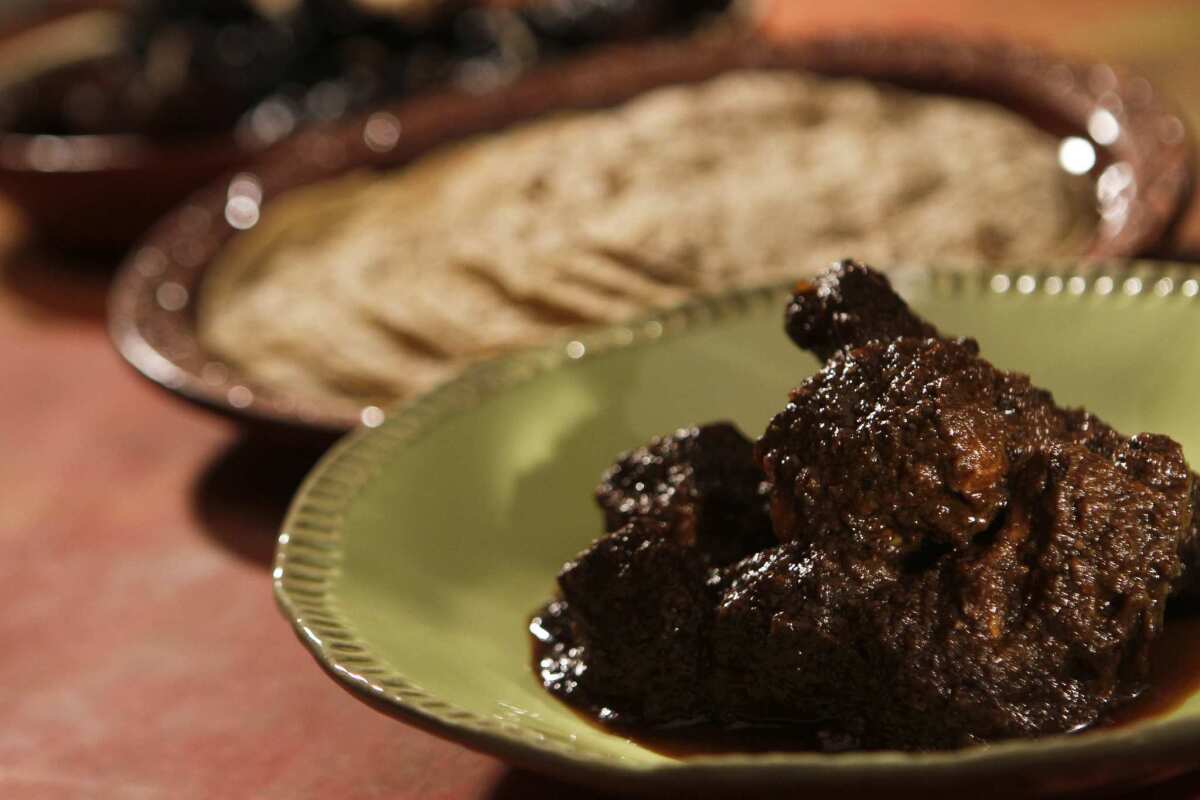Recipe: <i>Carne de cerdo en pulque</i> (Pork in <i>pulque</i> sauce)

Total time: 2½ hours, plus marinating time
Servings: 6 to 8
Note: Because fresh pulque is difficult to find in the U.S., beer freshened with a little lemon juice is a legitimate substitute; the dish will taste a little different but just as good. The chiles and piloncillo should be available at Latin markets, as well as Latin sections of many well-stocked grocery stores; they are also available online (if you cannot find all of the dried chiles, use as many as you can find, adding extra of one of the listed varieties to make up for not having enough of another). The dish can be served with steamed rice and/or with a stack of warmed corn tortillas to make tacos.
Marinated pork
2 cups pulque (or substitute lager beer and 1 teaspoon lemon juice)
3 large cloves garlic
1 onion
1 teaspoon freshly ground pepper
1/2 teaspoon salt
1 pound pork loin, cut into 2-inch cubes
1 pound pork spare ribs, separated and cut in 3-inch lengths (your butcher can do this)
In the bowl of a food processor, puree the onion and garlic. Move the puree to a large glass or ceramic bowl. Stir in the pulque, pepper and salt. Add the meat, tossing with your hands to coat, then cover and refrigerate, marinating the meat for at least 12 hours.
Carne de cerdo en pulque assembly
3 ancho chiles (1 ounce)
2 mulato chiles (1½ ounces)
2 guajillo chiles (½ ounce)
2 dried Pasilla chiles (½ ounce)
2 dried chipotles (½ ounce) or 1 canned chipotle
3 cloves garlic unpeeled
1 onion, roughly chopped
1/2 cup (2½ ounces) piloncillo or dark brown sugar
3 whole cloves
3 whole allspice
1/2 teaspoon ground cinnamon
1 pinch dried oregano, preferably Mexican
1 cup water, beef or chicken broth
1 teaspoon salt
Marinated pork
1/4 cup olive oil
1 cup water
1. Prepare the chiles: Heat a dry comal or heavy skillet (such as cast iron) over a medium flame. Press each chile, one at a time, onto the surface with a flat tool such as a potato masher or the back of a spatula until the chile puffs, blisters and reddens, no more than 8 seconds on each side. Be careful not to burn the chiles — remove them immediately if they start to smoke — or the sauce will taste bitter. When all the chiles are toasted, open each one by tearing it at the stem end and empty out the seeds. Place the chiles in a bowl of hot tap water, leaving them submerged for about 20 minutes to soften.
2. On the same skillet, while you are preparing the chiles, toast the garlic cloves, turning from time to time until the skins darken. Don’t worry about blackening them entirely. When cool, the garlic will be translucent, softened and will pop out of its skin easily.
3. When chiles are softened, place them (discarding their soaking water) in a blender with the onion, garlic, piloncillo, cloves, allspice, cinnamon, oregano, water and salt, and puree. Turn off the blender and stir the sauce a few times with a rubber spatula, scraping the sides of the jar as you puree. Add a little more water if the sauce won’t turn in the blender. The sauce can be made up to a day in advance before using; cover and refrigerate it until needed.
4. Remove the pork from the marinade (reserve the marinade), and dry the pork using paper towels.
5. In a large, heavy casserole (or a Mexican ceramic cazuela), heat the oil over medium-high heat until hot. Add the pork, a few pieces at a time, browning the pieces on all sides. Place the browned meat on a plate and continue until all of the pork is browned.
6. Reduce the heat and add the sauce (be careful, as it may splatter). Cook the sauce for 5 to 6 minutes, stirring constantly with a wooden spatula, watching that it does not burn. Add back the pork, the reserved marinade and 1 cup of water. When the sauce comes to a simmer, reduce the heat to a very gentle simmer, loosely cover the pot and cook until the pork is tender, 1½ to 2 hours, stirring from time to time. If the sauce thickens too much before the pork is done, thin it with a little water. The finished sauce should have the thickness of an Italian tomato sauce.
Each of 8 servings: 340 calories; 22 grams protein; 21 grams carbohydrates; 3 grams fiber; 17 grams fat; 4 grams saturated fat; 69 mg cholesterol; 10 grams sugar; 530 mg sodium.
More to Read
Eat your way across L.A.
Get our weekly Tasting Notes newsletter for reviews, news and more.
You may occasionally receive promotional content from the Los Angeles Times.










